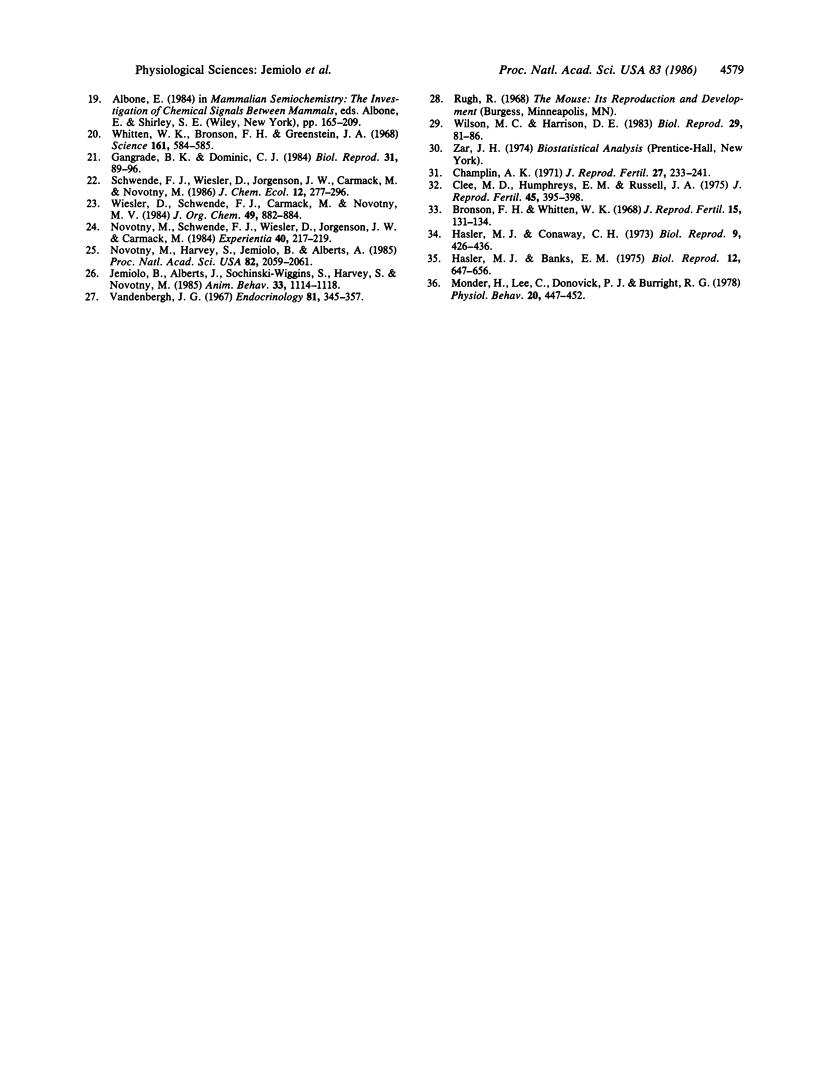Abstract
Two volatile constituents of male mouse urine, 2-(sec-butyl)-4,5-dihydrothiazole and dehydro-exo-brevicomin, were synthesized and tested for their ability to induce estrous cycle in female mice (the Whitten effect). The suppression of ovarian cycling activity that resulted from grouping the females was abolished by exposure to normal male urine. The synthetic compounds, when added together in appropriate concentrations to the (previously inactive) urine of castrated males, or even to water, were found to be as effective as normal male urine. The action of the synthetic compounds appears attenuated for singly caged females.
Full text
PDF



Selected References
These references are in PubMed. This may not be the complete list of references from this article.
- BRUCE H. M. A block to pregnancy in the mouse caused by proximity of strange males. J Reprod Fertil. 1960 Feb;1:96–103. doi: 10.1530/jrf.0.0010096. [DOI] [PubMed] [Google Scholar]
- Bronson F. H., Whitten W. K. Oestrus-accelerating pheromone of mice: assay, androgen-dependency and presence in bladder urine. J Reprod Fertil. 1968 Feb;15(1):131–134. doi: 10.1530/jrf.0.0150131. [DOI] [PubMed] [Google Scholar]
- Champlin A. K. Suppression of oestrus in grouped mice: the effects of various densities and the possible nature of the stimulus. J Reprod Fertil. 1971 Nov;27(2):233–241. doi: 10.1530/jrf.0.0270233. [DOI] [PubMed] [Google Scholar]
- Clee M. D., Humphreys E. M., Russell J. A. The suppression of ovarian cyclical activity in groups of mice, and its dependence on ovarian hormones. J Reprod Fertil. 1975 Nov;45(2):395–398. doi: 10.1530/jrf.0.0450395. [DOI] [PubMed] [Google Scholar]
- Gangrade B. K., Dominic C. J. Studies of the male-originating pheromones involved in the Whitten effect and Bruce effect in mice. Biol Reprod. 1984 Aug;31(1):89–96. doi: 10.1095/biolreprod31.1.89. [DOI] [PubMed] [Google Scholar]
- Hasler J. F., Banks E. M. The influence of exteroceptive factors on the estrous cycle of the collared lemming (Dicrostonyx groenlandicus). Biol Reprod. 1975 Jun;12(5):647–656. doi: 10.1095/biolreprod12.5.647. [DOI] [PubMed] [Google Scholar]
- Hasler M. J., Conaway C. H. The effect of males on the reproductive state of female Microtus ochrogaster. Biol Reprod. 1973 Nov;9(4):426–436. doi: 10.1093/biolreprod/9.4.426. [DOI] [PubMed] [Google Scholar]
- Konat G. W., Wiggins R. C. Effect of reactive oxygen species on myelin membrane proteins. J Neurochem. 1985 Oct;45(4):1113–1118. doi: 10.1111/j.1471-4159.1985.tb05530.x. [DOI] [PubMed] [Google Scholar]
- LAMOND D. R. Effect of stimulation derived from other animals of the same species on oestrous cycles in mice. J Endocrinol. 1959 Jul;18:343–349. doi: 10.1677/joe.0.0180343. [DOI] [PubMed] [Google Scholar]
- MARSDEN H. M., BRONSON F. H. ESTROUS SYNCHRONY IN MICE: ALTERATION BY EXPOSURE TO MALE URINE. Science. 1964 Jun 19;144(3625):1469–1469. doi: 10.1126/science.144.3625.1469. [DOI] [PubMed] [Google Scholar]
- Monder H., Lee C. T., Donovick P. J., Burright R. Male mouse urine extract effects on pheromonally mediated reproductive functions of female mice. Physiol Behav. 1978 Apr;20(4):447–452. doi: 10.1016/0031-9384(78)90327-x. [DOI] [PubMed] [Google Scholar]
- Novotny M., Harvey S., Jemiolo B., Alberts J. Synthetic pheromones that promote inter-male aggression in mice. Proc Natl Acad Sci U S A. 1985 Apr;82(7):2059–2061. doi: 10.1073/pnas.82.7.2059. [DOI] [PMC free article] [PubMed] [Google Scholar]
- Novotny M., Schwende F. J., Wiesler D., Jorgenson J. W., Carmack M. Identification of a testosterone-dependent unique volatile constituent of male mouse urine: 7-exo-ethyl-5-methyl-6,8-dioxabicyclo[3.2.1]-3-octene. Experientia. 1984 Feb 15;40(2):217–219. doi: 10.1007/BF01963608. [DOI] [PubMed] [Google Scholar]
- VAN DER LEE S., BOOT L. M. Spontaneous pseudopregnancy in mice. II. Acta Physiol Pharmacol Neerl. 1956 Dec;5(2):213–215. [PubMed] [Google Scholar]
- VAN DER LEE S., BOOT L. M. Spontaneous pseudopregnancy in mice. Acta Physiol Pharmacol Neerl. 1955 Nov;4(3):442–444. [PubMed] [Google Scholar]
- Vandenbergh J. G. Effect of the presence of a male on the sexual maturation of female mice. Endocrinology. 1967 Aug;81(2):345–349. doi: 10.1210/endo-81-2-345. [DOI] [PubMed] [Google Scholar]
- Vandenbergh J. G., Finlayson J. S., Dobrogosz W. J., Dills S. S., Kost T. A. Chromatographic separation of puberty accelerating pheromone from male mouse urine. Biol Reprod. 1976 Sep;15(2):260–265. doi: 10.1095/biolreprod15.2.260. [DOI] [PubMed] [Google Scholar]
- Vandenbergh J. G., Whitsett J. M., Lombardi J. R. Partial isolation of a pheromone accelerating puberty in female mice. J Reprod Fertil. 1975 Jun;43(3):515–523. doi: 10.1530/jrf.0.0430515. [DOI] [PubMed] [Google Scholar]
- WHITTEN W. K. Occurrence of anoestrus in mice caged in groups. J Endocrinol. 1959 Jan;18(1):102–107. doi: 10.1677/joe.0.0180102. [DOI] [PubMed] [Google Scholar]
- Whitten W. K., Bronson F. H., Greenstein J. A. Estrus-inducing pheromone of male mice: transport by movement of air. Science. 1968 Aug 9;161(3841):584–585. doi: 10.1126/science.161.3841.584. [DOI] [PubMed] [Google Scholar]
- Wilson M. C., Harrison D. E. Decline in male mouse pheromone with age. Biol Reprod. 1983 Aug;29(1):81–86. doi: 10.1095/biolreprod29.1.81. [DOI] [PubMed] [Google Scholar]


